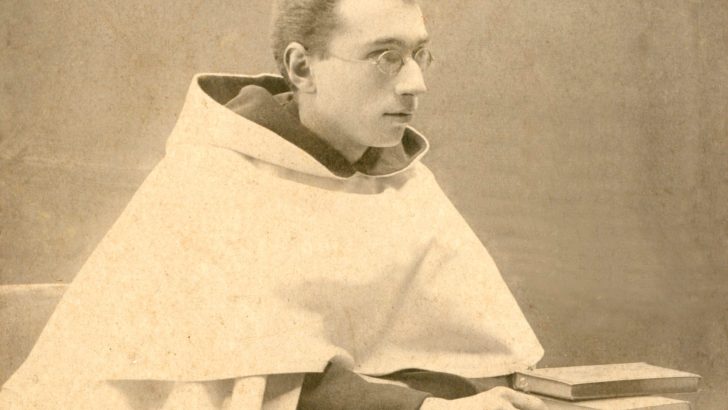The Price of Truth: Titus Brandsma, Carmelite by Miguel Arribas, O. Carm Carmelite dia, US$23.85/£19.60/€23.50
“It was around six o’clock Monday evening, 19 January 1942, when two burly young men rang the doorbell of the Carmelite Priory in Nijmegen in Holland. The brother porter greeted the visitors and enquired, ‘how may I help you, gentlemen?’ The younger of the two responded in Dutch: ‘We would like to speak with Professor Brandsma. We are in a hurry. Please let him know.’
“The brother ushered them into a parlour and called Fr Titus Brandsma. He came down at once and greeted his guests cordially.
“At this stage the previously silent visitor announced in German: ‘My name is Steffen: I am an agent of the State Security Police. By order of the Security Service, you are under arrest. You are to come with me on the 7.35 train to Arnhem’.”
Thus began the journey which ended with the death of Titus Brandsma at Dachau Concentration Camp on July 26 1942 as a result of a deadly injection of carbolic acid.
Titus Brandsma was born in Bolsward in the north of Holland on February 23 1881. His father was a farmer. The family were religious: four of Titus’ five siblings joined religious orders.
After receiving his early education in a Franciscan college, Titus entered the novitiate of the Carmelite Priory at Boxmeer in September 1898. He was ordained in June 1905 and spent the next four years pursuing further studies in Rome.
On returning to Holland Titus was appointed professor of philosophy and Church history in the Carmelite major seminary in Oss. Next he served as the professor of philosophy in the newly-established Catholic University at Nijmegen, eventually becoming the Rector Magnificus in 1932.
Prolific
Besides his academic work, Titus was a prolific contributor to journals: national and international, professional and popular. By the late 1930s Titus was one of the best-known persons in Holland. He was a member of the Union of Catholic Journalists (UCIP) and a card-carrying member of the Fourth Estate. Thus in March 1935 the leader of the Catholic Church in Holland, Archbishop de Jong of Utrecht, appointed him chaplain to the Union of Catholic Journalists.
In the meantime National Socialism had come to the fore in Germany. On January 30 1933 Adolf Hitler had appointed himself the country’s absolute leader. For Hitler the aim of National Socialism was to promote the supremacy of the Aryan race, or truly White Race.
This was first to be achieved by the ‘elimination’ of the Jewish race. Subsequently gypsies, the disabled, people with learning disabilities and all who opposed the ‘New Order’ were to ‘disappear’. Titus fearlessly and tirelessly criticised this hideous nonsense in the Dutch press and in various journals. He also conducted a series of lectures in the University highlighting the dangers and rank evil of this National Socialist ideology.
In May 1940 the Wehrmacht overran Holland. The new overlords set out to control the country. They began the round-up of the Dutch Jews. Next, recognising that the Faith of Christians was a direct threat to their worldview and atheistic ideology, they turned their attention to the country’s Catholic education system and the Catholic Press.
Because of his central role in both those areas – he was president of the Union of Catholic Schools and chaplain to the Union of Catholic Journalists – Titus became an obvious target of the new regime. Then he was also involved in assisting the Dutch bishops in an unsuccessful attempt to ensure that the editors of the Catholic Press would not be forced to transmit Nazi propaganda.
Arrest
After his inventible arrest Titus was incarcerated in a number of transit hubs before arriving in Dachau on June 19 1942. Some of those who provided witness statements during his beatification process had been fellow-inmates at Dachau and described the appalling maltreatment visited on him and the other prisoners.
By a curious coincidence the nurse who administered the lethal injection to Titus was also among those who provided witness statements at the beatification process. She told her own story. Aged 16, she was sent to Berlin to be trained as a nurse. She was then appointed to the medical centre in Dachau.
There she took part in the horrific experiments conducted by the SS doctors. If she or her colleagues refused to participate, she claimed they had just two choices: suicide or being prepared to be shot!
On November 3 1985 Pope John Paul II proclaimed Titus Brandsma a martyr and that his feast might be celebrated. On May 27 this year Titus was finally canonised by Rome, much to the joy of his fellow Carmelites in Dublin’s Whitefriar’s Street community, a community Brandsma visited in 1935.


 St Titus Brandsma
St Titus Brandsma 